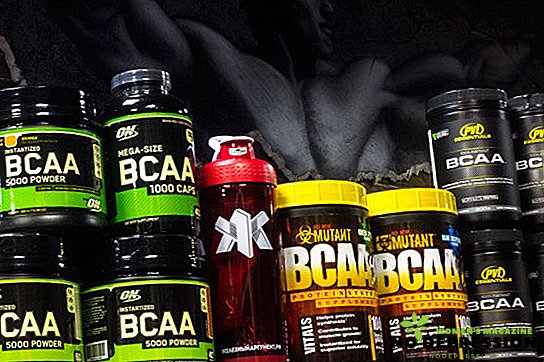Those who are seriously involved in sports and at least once were interested in sports nutrition, clearly heard the term "BCAA". Among all the variety of nutritional supplements for athletes, this is perhaps fanned by the greatest number of rumors and conjectures.

What is BCAA?
BCAAs are branched-chain amino acids. In fact, these are three amino acids in one "bottle":
- leucine;
- isoleucine;
- valine.
They are irreplaceable amino acids. Scientists believe that these substances are represented in the diet in a minimum quantity, and in fact it is on them that the rate of protein synthesis depends.
The most important of the three listed acids is leucine - its importance is as follows:
- It is leucine that is a powerful energy substrate, which is necessary for maintaining muscle work, provided that glucose is limited, for example, during a strict diet.
- Leucine synthesizes glutamine. This is a substance that is necessary to maintain immunity during high-intensity workouts.
- Impossible without it, and protein synthesis. So, there will be no muscle growth.
The only disadvantage of this substance is that in its pure form it is poorly absorbed due to its low bioavailability. But with the right combination with isoleucine and valine, the percentage of digestibility increases dramatically. Another important factor is the beneficial effect on the liver.
A protein diet, large amounts of food, and hard workouts (i.e., oxidative stress) have an adverse effect on the liver.
BCAA in high dosages promotes rapid recovery of the cells of the organ. According to many experts, the drug is much more effective than modern hepatoprotectors.
When to use and in what dosages?
The body of athletes on training days and on rest days, when all tissues are restored, has different needs for fast amino acids. Therefore, the regimen of supplementation on these days may vary.
During training
With active training in the athlete's body, not only anabolic processes are started, that is, muscle growth, but also catabolic, that is, destructive. The task of amino acids in this period is the stimulation of the first and the inhibition of the second processes.
If anabolic processes are activated on rest days, then catabolic processes, on the contrary, are most dangerous during physical exertion. During training periods, the body needs additional feeding. And if you do not give it, the body will start looking for reservoirs inside the body.
 First of all, glycogen stores in the liver and muscles. If this substance is not enough, the body begins to actively break down the amino acids that make up the muscles. In this case, the BCAA is ideal as an assistant. To the body did not begin to devour himself, he needs to offer something else.
First of all, glycogen stores in the liver and muscles. If this substance is not enough, the body begins to actively break down the amino acids that make up the muscles. In this case, the BCAA is ideal as an assistant. To the body did not begin to devour himself, he needs to offer something else.
Amino acids in this case are ideal. Due to the fact that these substances are almost instantly absorbed, they begin to be actively involved in the processes, they do not allow catabolism to develop during training, they also participate in building up muscles and burning fat mass.
BCAAs should be taken immediately before and immediately after classes. It will be useful to take a small amount of amino acids during physical activity, if their duration exceeds one hour. After training, when the glucose level is at a minimum, there are practically no amino acids in the body, it is necessary to replenish their stock. Due to this, the exchange processes, which will work at a furious pace for some time, will receive raw materials for processing.
In the days of rest
It is believed that taking amino acids on rest days is optional. Some believe that if there is no effect on the body (training), then there are no catabolism processes. However, it is not. Catabolic processes are most active immediately after sleep. If at this moment to get protein from normal food or take protein, the body will need some time to break it down into amino acids. Acceptance of VSAA in the morning will solve this problem, that is, amino acids will immediately get to the muscles. It is recommended to take one standard portion immediately after bedtime.
What kind of supplements are produced?
There are many forms of release of the BCAA. Every athlete can find a suitable option for themselves. In addition, the pharmacological form affects how much you need to drink the drug before workouts, because tablets, capsules or liquid solutions have different digestibility period.
In pills
Tablets - the most disadvantageous option for consumers. In essence, they are a compressed protein. How many of them are the active substance, and how many impurities, a big question. Their only plus is relatively low cost. Another relative advantage can be called a long period of release of the active substance. When taking the supplement in such a pharmacological form for the night there is every chance of avoiding pronounced night catabolism, especially if you are on a diet.
To figure out how to take amino acids in tablets, you need to study the instructions, the composition, determine the dosage. It is also recommended to contact a specialist with this question.
Capsules
 They are a fairly good pharmacological form with excellent bioavailability. In addition, the capsules are wrapped in an enteric membrane, due to which they do not increase the acidity of the gastric juice, the drug is rapidly absorbed into the blood and begins to act for a maximum of half an hour. Thus, the optimal time for admission - half an hour before the start of training.
They are a fairly good pharmacological form with excellent bioavailability. In addition, the capsules are wrapped in an enteric membrane, due to which they do not increase the acidity of the gastric juice, the drug is rapidly absorbed into the blood and begins to act for a maximum of half an hour. Thus, the optimal time for admission - half an hour before the start of training.
Regarding how to take the product in capsules, it depends on the amount of active substance that is contained in the preparation. It is also important to know your weight, because the more it is, the more capsules you need to take at a time. For example, if one capsule contains 500 mg of the main component, then for an athlete weighing 90 kg a single dosage is 6 capsules.
Most manufacturers specify this information in the instructions for use of tablets.
Liquid form
It is a leader in the rate of assimilation. Any liquid is absorbed even in the oral cavity, so that the time during which the amino acids get into the blood is calculated in just a few minutes. This is especially true for those who conduct high-intensity workouts during periods of diets, for example, before an important competition.
Powder
Powder form is used to make drinks. They are absorbed quickly enough. There are two types of powdered amino acids: with taste flavors and without them. There is one important nuance here. If you are a supporter of healthy nutrition, naturalness, you still should not buy amino acids without admixture. The fact is that a simple powder has a very bitter taste, that it is almost impossible to drink it, regardless of the beverage you choose to make.
An important point: many believe that when making a drink, a film should appear on the surface. However, this is not the case. Modern additives dissolve well in a liquid medium, so, rather, on the contrary, as a result of incomplete dissolution of amino acids, this may indicate a not very high quality of the feedstock. It may also indicate that there is creatine in the powder. Therefore, it is important to read the label with the composition.
The dosage is as follows: take about 36 mg of supplement per 1 kg of weight.
Chewable tablets
Another specific form of supplement. It has several advantages, such as good bioavailability, rapid onset of action. What is important, these chewable tablets are a dietary product with a high content of amino acids and glutamine. It should also be noted that against the background of the diet, this product will allow it to keep it cleaner, because it gives psychological relief - you can eat a little sweet, while not harming the progress of fat burning.
Optimum portion of VSAA
Each manufacturer of sports nutrition indicates a different dosage, regardless of the weight of the athlete. How to correctly calculate the appropriate dosage for you? Most coaches agree that for every kilogram of its own weight, an athlete should receive approximately 30-38 mg of BCAAs per workout. Thanks to this, it is very easy to calculate a suitable dosage.
For example, if your weight is 75 kg, then for one workout you need to take at least 2475 mg. With a standard ratio of 2: 1: 1, it will be about 5 g of amino acids. Knowing this formulation, you can easily calculate how much BCAA you need, regardless of the form of release - for this you just need to examine the label, which indicates the content of leucine in one portion.
Is it possible to combine with other additives?
If you are interested in whether you can drink BCAAs, if you additionally use protein or gainer, then the answer is yes. This is a pretty good idea, because in this way you can accelerate the growth of muscle mass and fill the body with essential acids.

The important point is that there are amino acid preparations that are diverse in composition of the protein mixture. Speaking of proteins, it is necessary to immediately clarify about soy protein and protein, which is synthesized from wheat. So, any vegetable protein is defective - it does not contain a full range of essential amino acids, which means that they cannot provide 100% protein synthesis in the athlete’s body.
To compensate for the deficiency of essential acids required, you must take BCAA. If we talk about vegetarians, the dosage of amino acids should be increased by 2-3 times to compensate for the deficiency of amino acids in the diet.
Are there any side effects?
Many people today have various doubts about the use of BCAAs. Since amino acids of this kind are necessary for the body to function, with intensive loads, additional administration will not cause any negative reactions or disturbances in the human body.
Also, do not fear and overdose - if any components do not have time to digest, they will leave the body without disturbing the internal balance.












